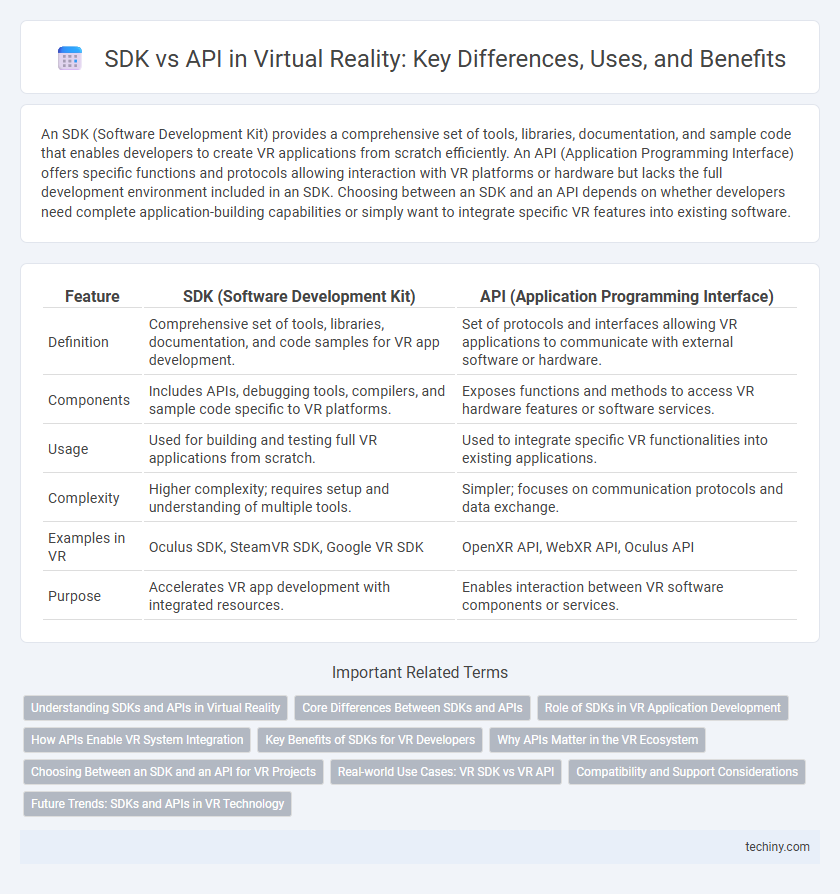An SDK (Software Development Kit) provides a comprehensive set of tools, libraries, documentation, and sample code that enables developers to create VR applications from scratch efficiently. An API (Application Programming Interface) offers specific functions and protocols allowing interaction with VR platforms or hardware but lacks the full development environment included in an SDK. Choosing between an SDK and an API depends on whether developers need complete application-building capabilities or simply want to integrate specific VR features into existing software.
Table of Comparison
| Feature | SDK (Software Development Kit) | API (Application Programming Interface) |
|---|---|---|
| Definition | Comprehensive set of tools, libraries, documentation, and code samples for VR app development. | Set of protocols and interfaces allowing VR applications to communicate with external software or hardware. |
| Components | Includes APIs, debugging tools, compilers, and sample code specific to VR platforms. | Exposes functions and methods to access VR hardware features or software services. |
| Usage | Used for building and testing full VR applications from scratch. | Used to integrate specific VR functionalities into existing applications. |
| Complexity | Higher complexity; requires setup and understanding of multiple tools. | Simpler; focuses on communication protocols and data exchange. |
| Examples in VR | Oculus SDK, SteamVR SDK, Google VR SDK | OpenXR API, WebXR API, Oculus API |
| Purpose | Accelerates VR app development with integrated resources. | Enables interaction between VR software components or services. |
Understanding SDKs and APIs in Virtual Reality
SDKs in virtual reality provide comprehensive toolsets including libraries, debugging tools, and documentation to streamline the development of immersive VR applications. APIs serve as specific interfaces enabling communication between software components, facilitating functionalities like tracking head movement or rendering 3D graphics within the VR environment. Understanding the distinction aids developers in leveraging SDKs for end-to-end development while using APIs to integrate specific VR features effectively.
Core Differences Between SDKs and APIs
SDKs in virtual reality provide a comprehensive set of tools, libraries, and documentation enabling developers to create, test, and deploy immersive VR applications efficiently. APIs offer specific interfaces allowing software components to communicate and access functionalities within VR platforms, streamlining integration and feature utilization. The core difference lies in SDKs delivering an all-encompassing development environment, while APIs serve as modular interaction points for distinct services or functions.
Role of SDKs in VR Application Development
SDKs play a crucial role in VR application development by providing comprehensive tools, libraries, and documentation that streamline the creation of immersive experiences. Unlike APIs, which offer specific functions for interaction, SDKs encompass a broader suite of resources, including APIs, debugging tools, and sample code tailored for VR hardware and platforms. This integrated environment accelerates development, ensures compatibility with VR devices, and enhances the performance and user experience of VR applications.
How APIs Enable VR System Integration
APIs enable seamless integration of diverse VR hardware components and software services by standardizing communication protocols and data exchange formats. They allow developers to access and control VR sensors, rendering engines, and input devices, ensuring synchronized and immersive user experiences. Leveraging APIs simplifies the connection between VR applications and external systems such as motion tracking, haptic feedback, and cloud-based rendering platforms.
Key Benefits of SDKs for VR Developers
SDKs for VR developers provide comprehensive tools, libraries, and documentation designed to streamline the creation of immersive virtual environments. They enable faster development cycles by offering pre-built components and compatibility with various VR hardware, reducing integration complexity. Access to specialized VR features like spatial audio, motion tracking, and gesture recognition within SDKs enhances the overall user experience and facilitates innovation.
Why APIs Matter in the VR Ecosystem
APIs in the virtual reality ecosystem enable seamless communication between VR hardware and software, facilitating immersive user experiences by providing standardized access to device capabilities. They allow developers to integrate diverse VR functionalities such as motion tracking, spatial audio, and rendering optimizations without building from scratch. This interoperability accelerates innovation and ensures consistent performance across multiple VR platforms.
Choosing Between an SDK and an API for VR Projects
Choosing between an SDK and an API for VR projects depends on the level of control and ease of integration required; SDKs offer comprehensive tools, libraries, and documentation tailored for virtual reality development, accelerating the build process with pre-built components. APIs provide more granular access to specific VR device functionalities and services, enabling customization and flexibility but often requiring more manual coding. Developers should evaluate project scope, timeline, and desired functionality to determine whether the all-in-one approach of an SDK or the modular approach of an API best suits their VR application needs.
Real-world Use Cases: VR SDK vs VR API
VR SDKs provide comprehensive development environments with tools, libraries, and sample code for building immersive applications, streamlining the creation of 3D environments and interactions. VR APIs offer specific functionalities such as sensor data access, motion tracking, and rendering capabilities, enabling precise control over hardware components in real-time. Use cases show VR SDKs are preferred for holistic application development, while VR APIs excel in integrating specialized features or enhancing existing VR platforms.
Compatibility and Support Considerations
SDKs offer comprehensive tools and libraries designed to ensure broad compatibility with various VR hardware and software platforms, facilitating smoother integration and faster development. APIs provide specific interfaces for communication between software components but may require additional development effort to support multiple devices and platforms effectively. Choosing between SDK and API depends on the need for extensive compatibility, where SDKs typically deliver more robust support for diverse VR systems.
Future Trends: SDKs and APIs in VR Technology
Future trends in VR technology emphasize the integration of advanced SDKs and APIs to streamline immersive experience development. SDKs will offer increasingly sophisticated tools for real-time rendering, gesture recognition, and spatial audio processing, enhancing VR application capabilities. APIs are evolving to support seamless interoperability across diverse VR hardware, enabling developers to create more connected and intuitive virtual environments.
SDK (software development kit) vs API (application programming interface) Infographic

 techiny.com
techiny.com